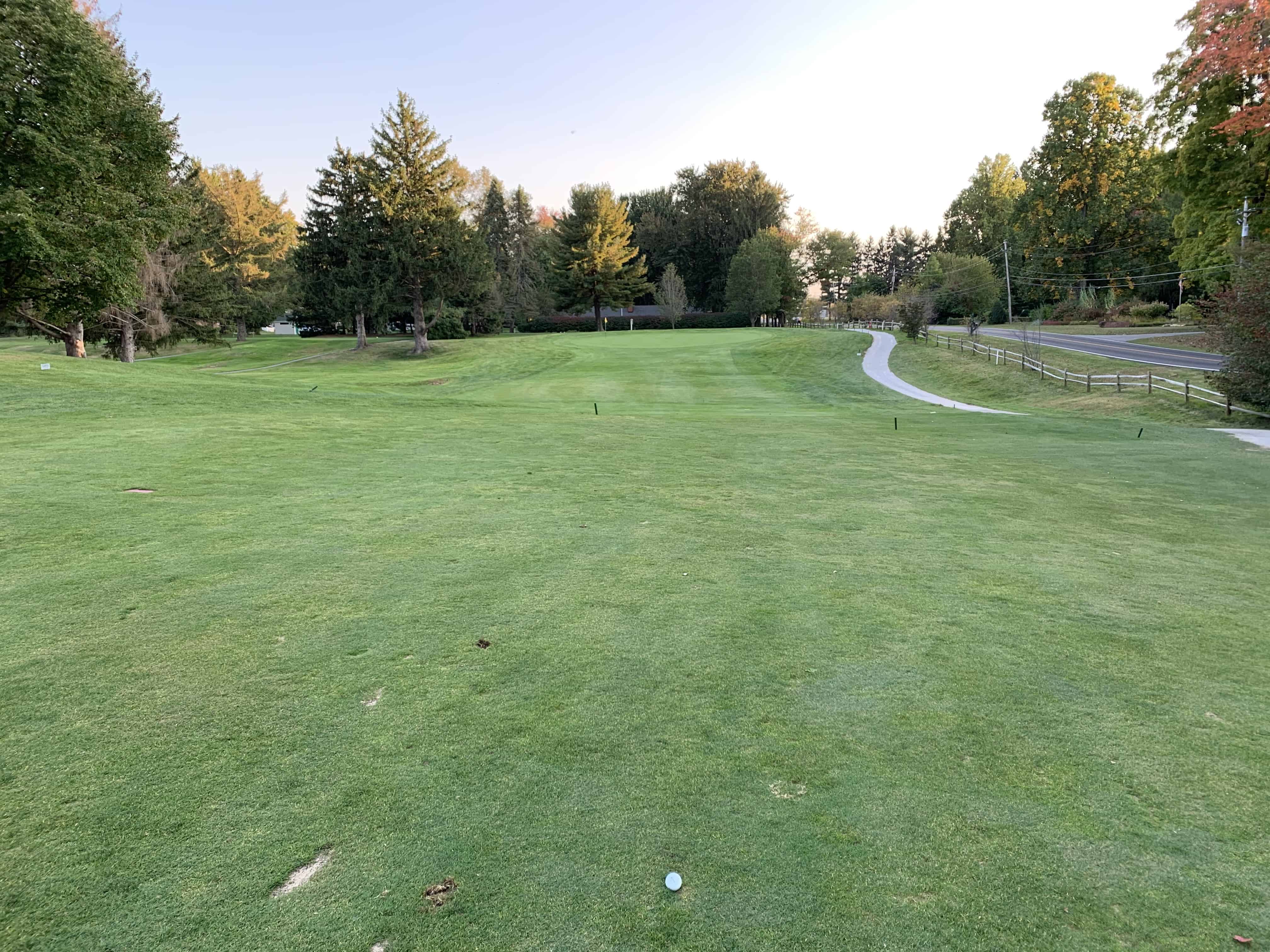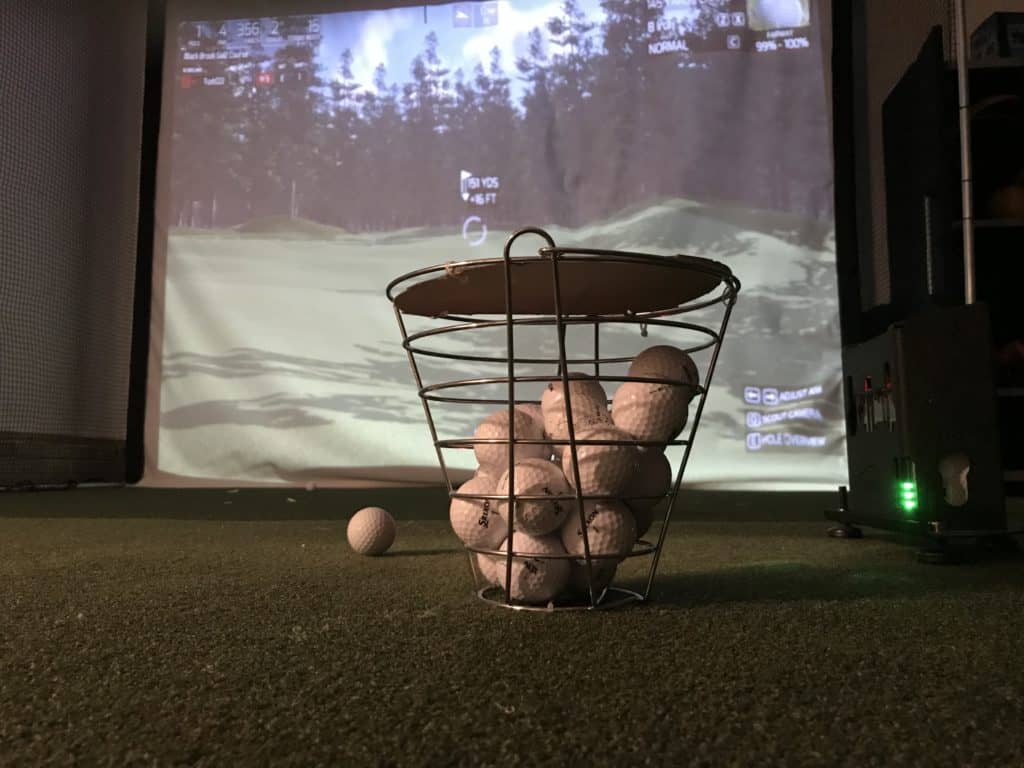5 Tips to hit a low iron shot:
- Play the ball back in your stance
- Keep your hands forward
- Stay shallow with your swing
- Hold off your release
- Use a 3 quarter backswing and take an extra club
The best golfers are able to hit high iron shots and low iron shots.
They are also able to work the ball both ways, hitting a draw or a fade when needed.
When I think of how Tiger Woods managed his game around a course, I think of the ultimate iron player. The golfer that could hit all of the shots when needed. High, low, fade, draw, high draw, high fade, low draw, low fade, etc.
While you may not ever get to his level, there are some options to help you better manage your game and to maximize your potential!
Having a go to stock shot is our number one recommendation when hitting the majority of your iron shots. Whether this is a stock draw or a stock fade, having a reliable ball flight pattern is important.
However, there are times when you will want to hit the ball low with your iron shots.
This is what we are going to help with today! How to hit a low iron shot! There are some key times in every round, when the best shot is a low flying, penetrating iron shot that leaves you in a great position.
Some of the times you may want to hit a low iron shot include:
- When hitting a shot with a moderate to severe wind.
- When the fairways are firm and rolling out.
- When there is trouble behind the green.
- When the pin is towards the back of the green.
We will dive into the when later in the post, but let’s get to the main topic.

How To Hit A Low Iron Shot (5 Tips)
Follow these 5 tips below!
Update: I have found that one of the keys to hitting a low iron shot is all about keeping your angle of attack somewhat neutral. Too much down on the ball and you can create unnecessary spin (which causes the ball to rise) and too much up will obviously launch the ball too high. Stay neutral!
Tip #1: Play the Ball Back in Your Stance
In order to hit a low flying shot, we need to take and deloft the club. Ultimately, we are taking a club like a 7 iron and delofting it closer to a 5 iron. Playing the ball back in your stance, helps your impact position result in a contact point where hands are still in front of the shot, the loft is decreased and you can compress the ball nice and low.
While hitting a low shot is possible from further up in your stance, it takes a great resistance of holding off the release when the ball is forward. We recommend experimenting around with different ball positions and how it reacts from a height perspective as well as a spin perspective. We want to find the right combination between these two to be able to control start line, curvature and overall distance.
Resource: How to hit your irons further (5 Tips)
Tip #2: Keep Your Hands Forward
One of the biggest obstacles many amateurs will face is the early release or casting of the club right at the beginning of the downswing. Go ahead and set up your smart phone from the side view and capture yourself trying to hit a low shot. You want to keep your hands forward at impact.
This starts with the setup and trying to get your hands to be in line with your front leg. The ball will be back, but your hands will be forward. This gets us back to delofting the club and ensuring that we are compressing the ball. There are two parts to check in your video:
- Where are your hands at setup? (They should be by your front leg)
- Where are your hands at impact? (They should be slightly ahead of the ball)
If neither happens in the swing, work on getting those hands forward at setup and then compressing the ball by turning through the shot and keeping your hands moving slightly left.
Tip #3: Stay Shallow With Your Swing
For years, many golfers would play the ball back in their stance and then get too steep on the downswing. This helped catch and compress the ball, but the spin rate increased to where the ball would balloon or start to float. The more shallow you can keep your swing, with your hands in front of the ball, the more you can optimize your spin rate.
Most golfers overlook the importance of spin rate and the impact it has on the height of the shot and the overall distance. When you over spin a ball, you will hit the ball higher and shorter. When you optimize your spin rate, you can control your ball flight and the distance it travels. Most of this starts with keeping your swing shallow at the right angle of attack.
To see if you are staying shallow, record your swing from behind and notice the angle that your hands take on the down swing. If they move out and over, your swing is likely too steep.
Tip #4: Hold Off Your Release
Holding off your release helps deloft the club. While there will be some release of the club to generate club head speed, you will notice that when many professionals hit a lower shot, they often have an abbreviated follow through. Experiment with different follow throughs to see and measure the impact it has on the flight of your golf ball.
Tip #5: Use A 3 Quarter Backswing and Take an Extra Club
If your normal 150 yard shot is an 8 iron and you need to keep the ball low for whatever reason, consider taking a 7 iron, playing the ball back in yoru stance and using a 3 quarter backswing. This will help you stay slightly more shallow, ensuring better contact and have less loft. This recipe will result in a lower flying, penetrating shot that will get through the wind or maximizing your landing area on the green or roll out on a firm fairway off a tee shot.
The 3 quarter swing is helpful and keeps you from over swinging which can cause an increase in spin rate, resulting in a higher flying shot that loses distance, especially if fighting a head wind.
Resource: How to hit the low punch shot in golf!

When To Hit A Low Iron Shot
Managing your golf game and your golf swing around a golf is one of the greatest challenges. Too often amateur golfers, take their exact club for that distance and make their regular swing. However, when faced with different conditions, hitting the low iron shot might be ideal. Here are the likely situations when you will want to hit a low iron shot:
- When hitting a shot with a moderate to severe wind.
- When the fairways are firm and rolling out.
- When there is trouble behind the green.
- When the pin is towards the back of the green.
#1: Moderate to Severe Wind
The wind is a major factor on a golf course. Whether the wind is blowing hard into your face or to your back, distance control becomes a battle. When the wind is blow hard left to right or right to left, you have trouble maintaining your start line especially if you draw or fade the ball moderately.
When faced in these conditions, working the ball under the wind can be advisable. Following the tips above, regardless of the wind will help you control your ball flight in these difficult conditions.
#2: Fairways Are Firm
If you head to the tee box of a 350 yard par 4 and can hit a low flying utility iron, hybrid or fairway wood in conditions where the fairway is going to roll out, the low flying tee ball with any of these clubs might be advisable. For example, I normally carry my utility iron between 210 and 220 yards.
If I can hit a low bullet like shot with my utility iron that flies to 210 and rolls out to 240-250, I am left with a simple 100-110 yard shot with a wedge, while taking the danger out of play with the driver. I am able to maximize the course conditions to my benefit.
Resource: Utility Iron vs Hybrid: Which one should I carry?
#3: Trouble Behind the Green
Flighting a ball lower and into a green where there is trouble behind the green, helps eliminate the trouble. The lower flying shot, if anything, will come up short. This is where your miss needs to be if there is moderate to severe trouble behind the green. With enough spin your ball will hop once or twice and stop quickly.
#4: Pin Towards Back of Green
When the pin is in the back, especially with a wedge in your hand, the lower flying shot becomes optimum. The lower flying wedge, that hops several times and then stops is easy to control with distance and eliminates the bad miss. It is a great shot in any condition, but even better when the wind is blowing and impacts the flight of the ball. When you can flight a shot lower, it helps eliminate a major variable in the game of golf! The Wind!
Resource: Why do I hit my driver so high?

Measure Your Swing
In the past several years, I have added a launch monitor to my golf game and it has made a major difference.
Not only am I able to play year round golf on my golf simulator, but the data I have at my fingertips after every swing is very helpful. I get the following data:
- Carry and Total Distance
- Launch Angle
- Spin Rate
- Spin Axis
- Ball Speed
This key data is great for working on hitting the different shots you might need such as the low iron shot. I am able to experiment in my golf simulator setup with my SkyTrak and not only get the data, but also see the shot tracer on every shot I hit. I can now work the ball both ways and hit the ball high or low as needed.
While we may not be able to afford a Trackman, there are some affordable options int he 500 to 2000 dollar range that are game changers. The SkyTrak and Mevo Launch Monitors are awesome additions of the amateur golfer.
Measuring your swing and see your launch angle and other key data can help you add more shots to your repertoire! Staying consistent with your approach and knowing your distances on a golf course is something that can set you apart from yoru playing competitor or your playing partners.
SkyTrak Launch Monitor: Golf’s Ultimate Game Improvement Tool!
Here are the top 3 options to check out:
I would recommend creating a chart with your wedges that looks like this:
| Club | Carry Distance (100%) | 90% | 80% |
| Pitching Wedge | 128 | 118 | 108 |
| Approach Wedge | 118 | 110 | 102 |
| SW Club | 105 | 97 | 91 |
| LW Club | 90 | 82 | 74 |
And and overall chart that resembles this chart:
| Club | Carry Distance (100%) | 90% | 80% |
| 4 iron | 190 | ||
| 5 iron | 181 | ||
| 6 iron | 171 | ||
| 7 iron | 163 | ||
| 8 iron | 153 | ||
| 9 iron | 143 | ||
| P Club | 130 | ||
| Approach Wedge | 118 | 110 | 102 |
| SW Club | 105 | 97 | 91 |
| LW Club | 90 | 82 | 74 |
Final Thoughts: How To Hit A Low Iron Shot
Experimentation and measuring your golf swing are the top two next steps for you. When you have the opportunity to test out different ball positions, swing thoughts, clubs and other variables you are working on taking your game to the next level.
When you can create a chart that has your average carry distances and use this as a resource on the course, you will hit more accurate iron shots and take your game to the next level.
Make sure you tap into the technology available to us in today’s golf world, get out and practice and start to play those elite level golf shots that will impress your friends and lower your golf scores!
Take Action – What You Can Do Today to Get Better
What does this mean for you? I believe in the following recipe to get better:
1 – Improve your motion in the golf swing by identifying a golf instructor. Here are some options:
Here is a list of golf instructors that we have reviewed:
2 – Train to swing faster and improve your swing speed. Here are some options:
Looking to gain more Speed and Distance in your swing. Two Options:
3 – Understand course strategy and work to break through your next barrier. Here is a series on breaking through:
We have provided guides on how to break 100, 90, 80 and 70. Check out more below, if interested.
4 – Practice Frequently
Did you know that I build a golf simulator in my garage and have played over 500 rounds of golf on my SkyTrak system? It has been a game changer and one worth checking out. Here are some of my other posts on golf simulators frequently asked questions:
- Is a Golf Simulator Worth It?
- How to Build a Golf Simulator?
- What is the Best Golf Simulator?
- Golf Simulator Accessories?
- How to Build a Golf Simulator for under $7000
- Top 11 Reasons to Buy a SkyTrak
- How to Build a Golf Simulator for Under $1000
- Why Build A Golf Simulator?
- What Space is Needed?
- Can A Golf Simulator Improve My Game?
- How Much Does A Golf Simulator Cost?
- Don’t Forget to Check out our 15 best golf swings of all time.
I am an amateur golfer on a journey to get better, enjoy the game as often as possible and share my passion and knowledge with others. I have coached high school golfers at a high level and have a great passion for the game and want to give back. I enjoy learning about the golf swing and am currently studying to be a certified professional golf instructor. Join me in our journey to get better everyday.

